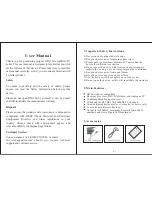
33
Maintenance
5
Maintenance
Precautions
WARNING
Don't expose personnel to the medical hazards of intense radio fre-
quency (RF) radiation. Whenever working on the tower in the area of
the antenna, turn off all transmitters and lock them out so that they can-
not be turned on accidentally.
Important
When you have had the system open for repair, you must purge it again
as described in
Purge the system
on page 27. Never begin operating the
system under power until you are sure all the moisture has been purged
from it. You can do permanent damage to the entire system, including
the transmitter.
CAUTION
When removing or replacing radiators on the tower, never let the weight
of the radiator hang on the inner conductor without bolting. This will
damage the connector and possibly the inner conductor itself. Support
the weight of the radiator until the flange bolts are tightened.
CAUTION
All O-rings are made of silicone. Do not lubricate them with silicone
grease, as this will soften the O-ring. Use only a light lubricating coat of
O-Lube (provided) or petroleum jelly; too much may hamper electrical
contact and contaminate the interior of the system.
Be sure the O-ring is properly seated in its groove and not pinched
between the flange contact surfaces.
Maintenance log
Shively recommends that you keep a maintenance log; in it record perfor-
mance parameters such as readings of VSWR and de-icer current draw.
Such a log can be invaluable in spotting and identifying problems.
Sample
maintenance log
on page 37 shows a suggested log form you may use if you
like.
Physical inspection
The antenna system should operate for years if properly installed and main-
tained. Shively Labs recommends that as a minimum, the antenna should be
physically inspected
at least once a year
.
In addition, inspect the antenna after severe weather events, and after climb-
ers have been on the tower working on equipment above the antenna.
In addition to checking the general condition of the antenna and coax:
• Replace dented, broken or bent components.
• Inspect radomes for cracks and plugged drain holes.
• Re-tighten all hardware, hose clamps, and U-bolts to installation
specifications.
• Inspect hose clamps and U-bolts carefully for signs of wear or
fatigue caused by vibration or tower movement.
WARNING
Maintenance should be
performed only by per-
sonnel experienced in RF
systems and familiar with
this equipment.
Important
Give your antenna a full
inspection at least once
per year!






































